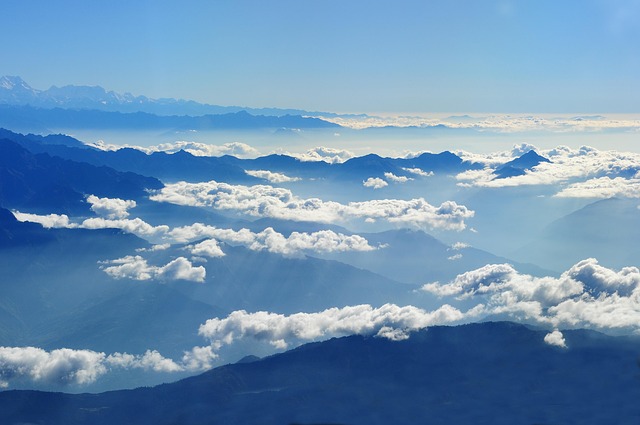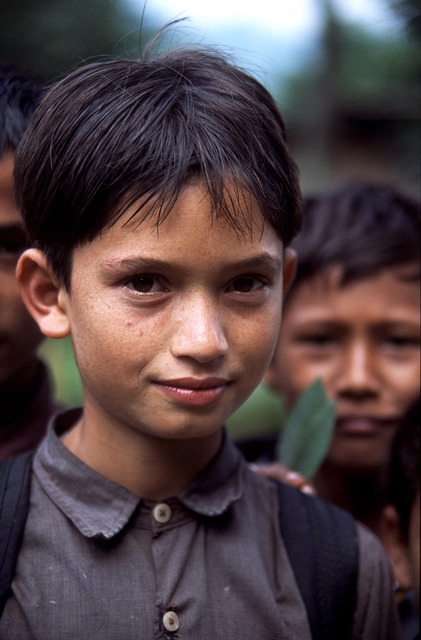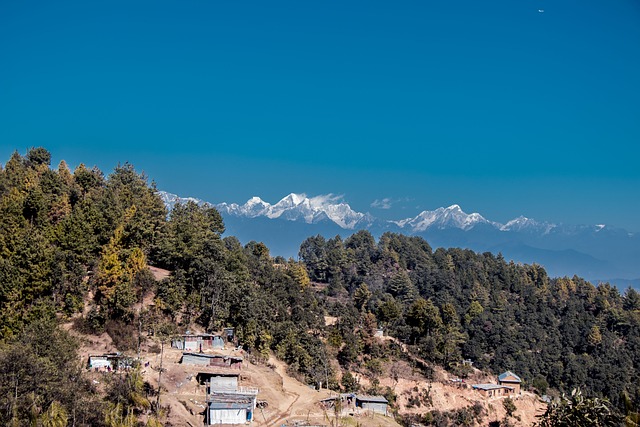Nepal's cultural heritage sites, including Kathmandu's landmarks and Patan Durbar Square, showcase the country's rich history and diverse ethnic traditions. Sustainable tourism practices aim to preserve Nepal's natural beauty and ancient traditions while fostering economic growth. Vibrant markets in Kathmandu offer unique cultural experiences with lively negotiations, traditional fabrics, and delicious local cuisine.
Explore the ancient city of Kathmandu, home to vibrant markets, historic temples, and cultural heritage sites.
Embark on a transformative trekking adventure in the Himalayas, offering breathtaking views and challenging hikes.
Discover the diverse ecosystems of Nepal, ranging from lush terai plains to snow-capped mountain peaks.
Immerse yourself in the local culture by attending traditional festivals like Dashain or Tihar.
Indulge in delicious Nepalese cuisine, featuring flavorsome curries, momos (dumplings), and hot teas.
Visit historic landmarks such as Boudhanath Stupa and Swayambhunath Temple for spiritual and architectural wonders.
Engage in volunteer work or community projects, contributing to the preservation of Nepal’s natural and cultural treasures.
Nepal, a breathtaking country nestled in the Himalayas, offers a captivating blend of rich cultural heritage and adventurous experiences. From the majestic peaks of the Annapurna Range to the serene rivers flowing through lush valleys, Nepal is a paradise for nature enthusiasts. Explore ancient temples and vibrant markets in Kathmandu, or trek to iconic sites like Everest Base Camp. Immerse yourself in the warmth of local hospitality and discover why Nepal is a must-visit destination for travelers seeking adventure and cultural immersion.
- Exploring Nepal's Cultural Heritage Sites
- Adventures in Nature: Mountains to Rivers
- Immerse Yourself in Kathmandu's Vibrant Markets
Exploring Nepal's Cultural Heritage Sites

Nepal is a treasure trove of cultural heritage sites that offer a glimpse into its rich history and diverse traditions. From ancient temples and stupas to historic palaces and vibrant markets, visitors can immerse themselves in the country’s spiritual and architectural marvels. The capital city, Kathmandu, boasts iconic landmarks like Pashupatinath Temple, Boudhanath Stupa, and Durbar Squares, each holding immense cultural significance.
A nepal tour isn’t complete without exploring these heritage sites. They not only showcase the nation’s artistic prowess but also provide a deeper understanding of its diverse ethnic groups and their unique contributions. Whether it’s witnessing the morning prayers at Pashupatinath or wandering through the bustling streets of Patan Durbar Square, every site tells a story that captivates both locals and tourists alike.
Adventures in Nature: Mountains to Rivers

Immerse Yourself in Kathmandu's Vibrant Markets

Kathmandu’s vibrant markets are a must-visit for any Nepal tour. As you wander through the narrow alleys, you’ll be surrounded by a symphony of sights, sounds, and smells. From the bustling Durbar Square to the lively Hanumandhoka Durbar Market, these markets offer a unique glimpse into Nepalese culture. Here, you can barter for colorful handicrafts, discover traditional fabrics, and indulge in local delicacies like Momo (steamed dumplings) or Chowmein (noodle dishes).
The energy is electric as locals and tourists alike engage in lively negotiations, creating an authentic and immersive experience. These markets are not just places to shop; they are a testament to the warmth and vibrancy of Nepalese life. So, take your time, immerse yourself in the hustle and bustle, and let the essence of Nepal tour you through its colorful heart.
Exploring Adventure and Culture: Kathmandu vs Pokhara vs Bhaktapur in Nepal
This comparison highlights the unique experiences offered by three vibrant destinations in Nepal, each with distinct charm and attractions.
| Feature | Kathmandu | Pokhara | Bhaktapur |
|—|—|—|—|
| Key Features | Nepal’s capital city; bustling metropolis with diverse culture and history | Picturesque lakeside town known for its natural beauty and outdoor adventures | Ancient medieval city preserved as a UNESCO World Heritage Site |
| Best Use Cases | Cultural immersion, historical exploration, vibrant street life, shopping & dining | Hiking, paragliding, boating, and exploring serene nature | Stepping back in time with traditional architecture, pottery, and crafting |
| Strengths | Rich history and cultural heritage; diverse food scene; vibrant nightlife; easy access to trekking routes | Stunning natural scenery; abundance of outdoor activities; peaceful ambiance; gateway to Annapurna region | Preserved medieval architecture; authentic Nepalese art and crafts; tranquil atmosphere |
| Limitations | Crowded streets; traffic congestion; pollution; limited peaceful retreats | Distance from major cultural sites; language barrier for some activities | Limited modern amenities; transportation options are mainly traditional |
| Cost/Performance | Mid-range to high cost; expensive for international travelers; good value for cultural immersion and city exploration | Mid-range cost; suitable for budget-conscious travelers seeking nature and adventure | Affordable; ideal for those looking for an authentic, culturally rich experience with minimal modern distractions |
Frequently Asked Questions About Things to do in Nepal
What are the best hiking trails for beginners in Nepal?
Nepal offers numerous breathtaking hiking trails suitable for beginners, such as the Everest Base Camp trek, which starts from Lukla and provides stunning views of the Himalayas. The Annapurna Circuit is another popular option, known for its diverse landscapes and cultural experiences. These treks typically range from 7-21 days and are guided by experienced locals, ensuring a safe and memorable journey for novice hikers.
Can I explore historical sites in Nepal?
Absolutely! Nepal boasts a rich cultural heritage with numerous historical sites. The Durbar Squares in Kathmandu, Patan, and Bhaktapur are UNESCO World Heritage Sites featuring ancient temples, palaces, and architecture showcasing the country’s history. Boudhanath Stupa and Swayambhunath Temple are iconic Buddhist sites that offer insights into the spiritual side of Nepal.
Are there opportunities for wildlife safaris?
Yes, Nepal is home to diverse wildlife, making it an ideal destination for nature enthusiasts. Chitwan National Park is a popular choice for tiger and elephant safaris. Visitors can enjoy jeep rides, canoe trips, and guided walks through lush forests, where they might spot rare animals like one-horned rhinos, wild elephants, and various bird species.
What cultural festivals can I participate in?
Nepal celebrates a vibrant array of cultural festivals, many of which are still observed today. Dashain and Tihar are two of the most significant Hindu festivals, celebrated with great enthusiasm across the country. The Festival of Lights (Tihar) features colorful lights, lanterns, and rituals honoring pets, while Dashain involves elaborate pandals (temporary temples) and traditional games. These festivals offer a unique glimpse into Nepali culture.
Is paragliding or skydiving available in Nepal?
Paragliding and skydiving are extreme sports enthusiasts’ secrets to paradise. Nepal’s diverse terrain provides excellent opportunities for these thrilling activities. Paragliding sites like Pokhara and Nuwakot offer breathtaking views of the Himalayas during flights. Skydiving centers in Katmandu provide jumps over scenic landscapes, making Nepal a top destination for adrenaline seekers.
What are the dining options in Nepal?
Nepali cuisine is a culinary adventure, known for its rich flavors and aromatic spices. Momos (steamed dumplings) and Thukpa (noodle soup) are popular street foods. Dal-bhat (lentil soup with rice), Tandoori chicken, and various vegetarian dishes reflect the country’s diverse cultural influences. Nepal also offers a range of international cuisines due to its growing tourism industry.
Revitalizing Tourism in Nepal’s Annapurna Circuit: A Community-Driven Approach
Situation
The Annapurna Circuit, a trek renowned for its breathtaking vistas and cultural richness, faced declining visitor numbers due to concerns about safety, lack of infrastructure, and limited tourism development. Local communities, dependent on trekking as their primary source of income, were negatively impacted by this decline. The region’s environmental sustainability was also at risk due to overuse and improper waste management practices.
Action
A collaborative initiative between the Nepalese government, local NGOs, and international trekking companies was launched to revitalize tourism in the Annapurna Circuit. This effort focused on three key pillars: community engagement, infrastructure development, and sustainable tourism practices.
Community members were actively involved in decision-making processes and trained in hospitality, guide services, and environmental conservation. New infrastructure like accommodation facilities, rest stations, and waste management systems were constructed with a focus on minimizing ecological impact. A comprehensive marketing strategy was implemented to promote the Circuit’s unique attractions and ensure responsible tourism practices among visitors.
Result
Within two years of implementation, the initiative yielded significant results:
Increased tourist numbers: The Annapurna Circuit witnessed a 35% increase in visitor arrivals compared to the previous year, reaching over 6,000 trekkers.
Economic benefits for locals: Local communities saw their income from trekking services surge by 28%, providing more opportunities for employment and improved living standards.
Enhanced environmental sustainability: Implementation of better waste management practices reduced solid waste discarded in the Circuit by 40% and encouraged responsible tourism behaviors among visitors.
– Explore iconic landmarks like Mount Everest, Annapurna, and the Durbar Squares of Kathmandu.
– Experience vibrant festivals such as Dashain, Tihar, and Teej, immersing yourself in local culture.
– Trek through breathtaking landscapes, from lush forests to high alpine passes.
– Discover diverse ethnic communities and their unique traditions and cuisines.
– Visit sacred sites like Swayambhunath and Pashupatinath for a spiritual experience.
– Enjoy thrilling activities like paragliding, rafting, and zip-lining in adventure hotspots.
– Indulge in traditional Newari cuisine and local street food for a culinary adventure.
– Participate in volunteer programs to contribute to local communities and conservation efforts.
Nepal offers a captivating blend of cultural heritage, breathtaking natural wonders, and vibrant urban experiences. From exploring ancient temples and bustling markets to embarking on thrilling mountain treks and river adventures, this diverse country promises an unforgettable journey. Whether you’re a history enthusiast, nature lover, or city explorer, Nepal’s unique charm will leave a lasting impression, making it a must-visit destination for travelers seeking authentic and enriching experiences.
